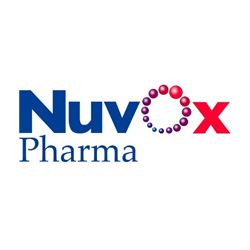
A life-threatening aspect of cancer and stroke is a reduction in the flow of oxygen from the lungs to blood and from blood to tissue, a condition known as hypoxia. The current standard of care for hypoxia relies on supplemental oxygen, hospital ventilators, or pressure chambers to increase blood oxygen levels in patients, but these approaches can be unsuccessful or challenging to implement. “There really hasn’t been an effective way to reverse hypoxia,” says Evan Unger, president and CEO of NuvOx Pharma.
In 2008, Unger co-founded NuvOx Pharma with Jenny Johnson and Terry Matsunaga to develop a new way to deliver oxygen to patients suffering from the low oxygen levels associated with many diseases, including cancer and stroke. The drug therapy they developed consists of microbubbles mixed with dodecafluoropentane emulsion (DDFPe) that arrive first at the lungs to pick up oxygen and then to hypoxic tissue, where they passively deliver the oxygen.
The emulsion containing the microbubbles, which are smaller in diameter than red blood cells, can safely be injected into a person’s bloodstream, where the microbubbles absorb oxygen as they circulate through lungs and are distributed through the body. “Gases carry about a thousand times as much oxygen as liquids, so the emulsion delivers oxygen very effectively. It imbibes oxygen in the bloodstream and the capillary lungs and then offloads it in areas with low oxygen,” Unger explains.
We could potentially improve the outcomes, lower the health care costs, and improve the quality of life for patients
Before the drug can be approved for use in patients, it must be tested in animals and humans to prove its safety and efficacy in reversing hypoxia. “The challenge is to be able to raise enough money to complete the studies and execute them,” Unger says.
Since 2008, the Tucson, AZ-based biotechnology company, has received support from Small Business Innovation Research (SBIR) and Small Business Technology Transfer grants from the National Institute of Neurological Disorders and Stroke, National Cancer Institute, National Institute of Child Health and Human Development, and National Heart, Lung, and Blood Institute to conduct preclinical and clinical research.
The company’s largest SBIR grant was awarded in 2017 to conduct a Phase IIB clinical trial to demonstrate the safety and efficacy of the oxygen therapeutic in treating glioblastoma. Results from this study can then be used to support a request for FDA approval to make the drug available to patients. NuvOx Pharma has also completed a clinical trial in patients with acute ischemic stroke, which also showed promising results.
Along with enabling the company to perform clinical trials, these grants attest to the viability of the oxygen therapeutic. “If a grant, which was submitted for scientific review by experts, is funded, then that’s a form validation that also helps you attract additional funding,” says Unger. To date, NuvOx Pharma has received $15 million in private financing.
In addition to the clinical work on stroke and glioblastoma, NuvOx is exploring the use of their oxygen therapeutic for COVID-19, traumatic brain injury, sickle cell crisis, myocardial infarction, and hemorrhagic shock. “We could potentially improve the outcomes, lower the health care costs, and improve the quality of life for patients,” he says.







